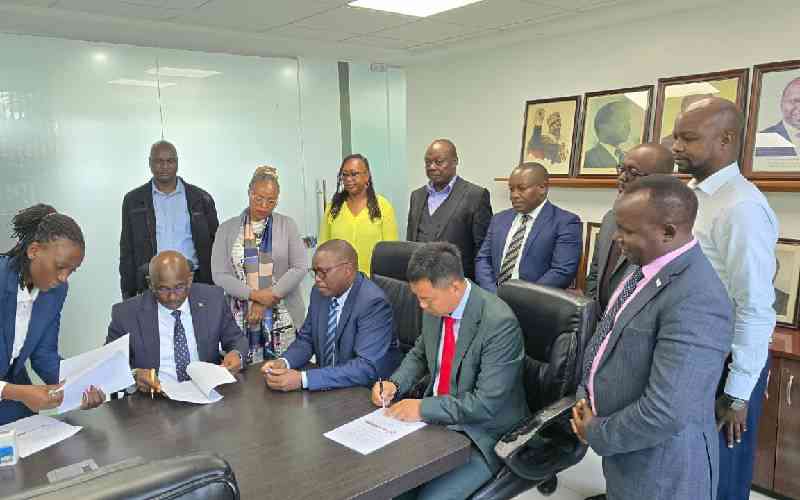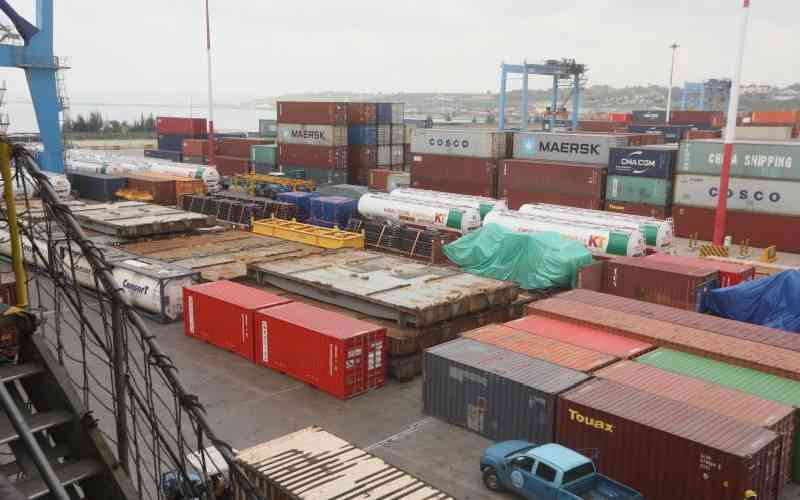
At least nine ships are scheduled to dock at the Lamu Port in August, signifying its growing importance in East Africa's seaborne trade as the region's small ports struggle with congestion.
The facility's General Manager, Captain Abdulaziz Mzee, said they were scaling up operations as more vessels from across the world have booked their schedules to drop cargo at the port.
Among the vessels lined up to dock at Lamu this month are CMA CGM Saigon, Stephanie C, Onego Buran, Lobivia, Myny, CMA-CGM Kailas Derby D and CMA CGM Tarragona.
This comes barely days after the port received the largest ever vessel to have called in the region, MV Nagoya Express, which picked up transshipment cargo destined for New York, USA.
The MV Nagoya Express, 335 metres long, arrived also days after the docking of the MV Lobivia and CMA CGM Gulf Express, signalling Lamu's growing traction as a regional transshipment hub.
'We are working round the clock to ensure that the Port of Lamu performs its role. Already the port with its natural deep harbour and larger turning basin is attracting many shipping lines which have made enquiries to sail here," Mzee said.
Mzee said that there are enquiries from, among others, the world's largest container shipping line, Mediterranean Shipping Company (MSC), and One Line, as well as Maersk Shipping.
Locally based firms led by Mombasa-based Spears Shipping Contractors Limited chief executive officer and founder chairman, Mr Mohamed Yusuf, announced that through their new subsidiary, Spears Point Maritime Limited, in association with Ikram Sealine of Zanzibar, they will venture into the Lamu port route.
Maritime commentator and former Seafarers Union of Kenya (SUK) general secretary, Andrew Mwangura, noted that the recent surge in vessel calls, exemplified by the historic arrival of the MV Nagoya Express—a 335-metre container ship, the longest ever to dock in East African waters—underscores Lamu’s potential to redefine trade dynamics in the region.
Mwangura said that these developments reflect a broader shift in global maritime logistics, where efficiency, scale, and strategic positioning are paramount.
Mwangura noted that as Lamu Port gains momentum, questions linger about its readiness to serve as the region’s premier transshipment hub, the need for specialised infrastructure like dedicated livestock berths, the deteriorating road connectivity, and its broader economic significance to regional blocs, the African Continental Free Trade Area (AfCFTA), the LAPSSET Corridor, and the Northern Corridor.
"The increase in vessel traffic at Lamu Port is no accident. Designed to handle ultra-large vessels that the Port of Mombasa cannot accommodate due to its 323-meter turning basin limitation, Lamu’s deep-water berths and 400-meter turning basin offer unparalleled capacity," he said.
Kenya Ports Authority (KPA), Mwangura further observed, has invested heavily in modern infrastructure, including high-capacity ship-to-shore gantry cranes, which enhances operational efficiency and attracts international carriers.
He noted that challenges such as security concerns near the Somali border and the need for robust stakeholder engagement remain critical hurdles to its long-term viability.
Mwangura explained that unlike Mombasa, which has long been the region’s maritime gateway but is constrained by its 15-metre draught, Lamu’s 17.5-metre depth allows it to handle post-Panamax vessels, aligning with global trends favouring larger ships to reduce costs and emissions.
Stay informed. Subscribe to our newsletter
The port’s role in transshipment—transferring cargo from one vessel to another for onwards delivery—positions Kenya to capture a larger share of the regional market, particularly for goods bound for Seychelles, Comoros, and Zanzibar.
"The arrival of more vessels exemplifies this potential, as they are likely to facilitate cargo transfers for regional and international destinations.
Competition from established ports like Dar es Salaam and Djibouti, coupled with Ethiopia’s heavy reliance on Djibouti’s port, poses challenges," said Mwangura, the former Suk boss said.
For Lamu to cement its status, continued investment in infrastructure, maritime security, and regional partnerships is essential.
He pointed out that KPA’s collaboration with the Kenya Navy and the Kenya Coast Guard Service has mitigated piracy risks, as evidenced by Kenya’s removal from the International Maritime Organisation’s piracy red list, but sustained efforts are needed to ensure safety and attract more shipping lines.
"One area where Lamu could further distinguish itself is through dedicated berths for livestock handling, a critical need given the region’s significant livestock trade, particularly with markets in the Middle East. Ethiopia and South Sudan, both key partners in the Lapsset corridor, are major livestock exporters, yet Lamu currently lacks specialised facilities to handle this trade efficiently," Mwangura explained.
Dedicated berths equipped with modern livestock handling infrastructure could streamline operations, reduce animal stress, and meet international sanitary standards, thereby boosting export volumes and creating jobs.







